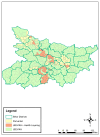Health layering of self-help groups: impacts on reproductive, maternal, newborn and child health and nutrition in Bihar, India
- PMID: 33425331
- PMCID: PMC7759023
- DOI: 10.7189/jogh.10.021007
Health layering of self-help groups: impacts on reproductive, maternal, newborn and child health and nutrition in Bihar, India
Abstract
Background: Self-help group (SHG) interventions have been widely studied in low and middle income countries. However, there is little data on specific impacts of health layering, or adding health education modules upon existing SHGs which were formed primarily for economic empowerment. We examined three SHG interventions from 2012-2017 in Bihar, India to test the hypothesis that health-layering of SHGs would lead to improved health-related behaviours of women in SHGs.
Methods: A model for health layering of SHGs - Parivartan - was developed by the non-governmental organisation (NGO), Project Concern International, in 64 blocks of eight districts. Layering included health modules, community events and review mechanisms. The health layering model was adapted for use with government-led SHGs, called JEEViKA+HL, in 37 other blocks of Bihar. Scale-up of government-led SHGs without health layering (JEEViKA) occurred contemporaneously in 433 other blocks, providing a natural comparison group. Using Community-based Household Surveys (CHS, rounds 6-9) by CARE India, 62 reproductive, maternal, newborn and child health and nutrition (RMNCHN) and sanitation indicators were examined for SHGs with health layering (Pavivartan SHGs and JEEViKA+HL SHGs) compared to those without. We calculated mean, standard deviation and odds ratios of indicators using surveymeans and survey logistic regression.
Results: In 2014, 64% of indicators were significantly higher in Parivartan members compared to non-members residing in the same blocks. During scale up, from 2015-17, half (50%) of indicators had significantly higher odds in health layered SHG members (Parivartan or JEEViKA+HL) in 101 blocks compared to SHG members without health layering (JEEViKA) in 433 blocks.
Conclusions: Health layering of SHGs was demonstrated by an NGO-led model (Parivartan), adapted and scaled up by a government model (JEEViKA+HL), and associated with significant improvements in health compared to non-health-layered SHGs (JEEViKA). These results strengthen the evidence base for further layering of health onto the SHG platform for scale-level health change.
Study registration: ClinicalTrials.gov number NCT02726230.
Copyright © 2020 by the Journal of Global Health. All rights reserved.
Conflict of interest statement
Competing interests: All authors completed the ICMJE Uniform conflict of interest disclosure form (available upon request from the corresponding author) and declare no competing interests.
Figures





References
-
- Transforming our World: The 2030 Agenda for Sustainable Development. Geneva, Switzerland: United Nations Development Program, 2015 Contract No.: A/RES/70/1.
-
- Brody C, De Hoop T, Vojtkova M, Warnock R, Dunbar M, Murthy P, et al. Economic self-help group programmes for improving women’s empowerment: a systematic review. London: International Initiative for Impact Evaluation (3ie); 2016.
-
- Kumar N, Raghunathan K, Arrieta A, Jilani A, Chakrabarti S, Menon P, et al. Social networks, mobility, and political participation: The potential for women’s self-help groups to improve access and use of public entitlement schemes in India. World Dev. 2019;114:28-41. 10.1016/j.worlddev.2018.09.023 - DOI - PMC - PubMed
-
- Sen A. The Many Faces of Gender Inequality: The New Republic; 2001.
